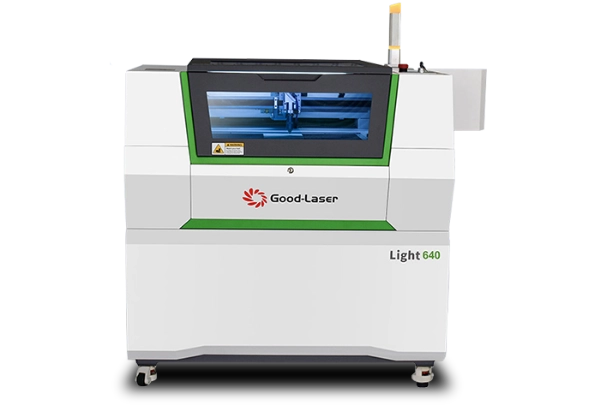Advantages of Desktop CO2 Laser Cutters for Education
The integration of laser cutters in educational settings has gained significant traction in recent years. These versatile, precise, and efficient tools offer a range of advantages that can dramatically enhance the learning experience, especially in STEM (science, technology, engineering, and mathematics) and art disciplines. In this blog post, Good-Laser will share the advantages of desktop CO2 laser cutter for education. From hands-on learning and creativity to building technology skills, it's priceless for both educators and students.
1. Precision and Versatility
One of the standout features of CO2 laser cutters is their ability to produce precise cuts and engravings on a wide variety of materials. CO2 lasers can effectively cut and engrave materials such as wood, acrylic, fabric, cardboard, and leather. This versatility enables students to work on diverse projects, allowing for cross-disciplinary applications. For example, students can design and fabricate parts for engineering projects, create artistic works, or prototype products for entrepreneurial ventures.
The high precision of desktop CO2 laser cutters also enhances learning outcomes. In engineering and design courses, accuracy is crucial, as it teaches students the importance of measurements and tolerances. The laser cutter' s ability to consistently replicate fine details enables students to visualize and fabricate their designs accurately, promoting both critical thinking and practical skills.
2. Enhanced Learning Through Hands-On Experience
CO2 laser cutters offer a practical, hands-on experience that enriches the learning process. Through project-based learning, students engage in tasks that require them to design, test, and iterate. The physical interaction with their own designs and prototypes fosters a deeper understanding of concepts, moving students from theoretical knowledge to practical application.
In educational environments, such tools cater to diverse learning styles. Visual learners can observe the laser cutter' s precise movements and understand how changes in design affect the outcome. Kinesthetic learners benefit from the tactile aspect of handling materials and assembling projects. This engagement encourages problem-solving, creativity, and collaboration - essential skills for students preparing for the workforce.
3. Exposure to Real-World Technology
CO2 laser cutters are widely used in industries such as manufacturing, architecture, fashion, and prototyping. By introducing students to this technology, educators bridge the gap between academic concepts and real-world applications. Students gain exposure to the processes and tools used by professionals, giving them a significant advantage in understanding industry-relevant skills.
Furthermore, desktop CO2 laser cutters often come with professional-grade design software, such as Adobe Illustrator or CAD software. Learning to operate these tools not only develops students' technical skills but also improves their digital literacy, preparing them for more advanced applications in fields like engineering, industrial design, and computer-aided manufacturing (CAM).

4. Cost-Effective Solution for Schools
Historically, CO2 laser cutters were prohibitively expensive and limited to industrial settings. However, desktop models have become more affordable and accessible to educational institutions, especially when compared to other fabrication equipment like CNC machines or industrial laser cutters. A desktop CO2 laser cutter requires minimal maintenance, consumes relatively little power, and often has a longer lifespan than other equipment, making it a cost-effective investment.
Moreover, desktop CO2 laser cutters typically have lower operating costs compared to other cutting technologies, such as plasma cutters or water jets, which require consumable parts or water disposal systems. The affordability of desktop laser cutters, coupled with their versatility, allows educational institutions to enhance their facilities without breaking budgets, making them ideal for STEM and art programs in schools and universities.
5. Rapid Prototyping and Iteration
In educational projects, particularly those focused on design and engineering, the ability to quickly prototype ideas is invaluable. Desktop CO2 laser cutters enable students to design, cut, and assemble their projects in a matter of hours, fostering an iterative design process. Instead of waiting for parts or materials to be ordered and delivered, students can make adjustments to their designs and re-fabricate components in real-time, speeding up the learning process.
Rapid prototyping not only saves time but also encourages a growth mindset. Students can learn from their mistakes, test alternative solutions, and adapt their designs quickly. This iterative approach is particularly valuable in science and engineering disciplines, where innovation and problem-solving are key skills. With a desktop CO2 laser cutter, students can experience the entire product development cycle - from concept to final product - within a single class session or project timeframe.
6. Safe and User-Friendly
Modern desktop CO2 laser cutters are designed with educational use in mind, featuring safety systems that make them suitable for classroom environments. These systems include enclosed designs, automatic shutoff mechanisms, and intuitive software interfaces, making the laser cutters safe and user-friendly for both students and teachers.
Many desktop laser cutters also come equipped with ventilation and filtration systems that minimize exposure to fumes generated during cutting or engraving. This ensures a safe environment for students, especially when working with materials like wood or acrylic that can release fumes when cut. The ease of operation also reduces the need for extensive training, allowing educators to integrate laser cutting into the curriculum quickly and safely.
7. Fostering Creativity and Innovation
Finally, desktop CO2 laser cutters open new avenues for creativity and innovation in education. By giving students the tools to bring their ideas to life, laser cutters encourage them to think outside the box and explore various design possibilities. In subjects like art, students can create intricate engravings, cut complex patterns, and experiment with layering and texture, adding depth to their projects.
In entrepreneurial programs, students can use laser cutters to create product prototypes, custom merchandise, or marketing materials. Such hands-on experience in product design and branding fosters an entrepreneurial mindset, encouraging students to think critically about design, functionality, and marketability.
Conclusion
The adoption of desktop CO2 laser cutters in educational settings offers a range of benefits, providing hands-on experience and exposure to industry-relevant skills, fostering creativity. By engaging students in rapid prototyping, iterating designs, and visualizing complex concepts in real time, CO2 laser cutting machines enhance STEM and arts education, and prepare students for the rapidly evolving job market. Affordable, safe, and versatile, laser cutting machines are a powerful addition to modern educational institutions, giving students the tools and confidence they need to excel in their future careers.




